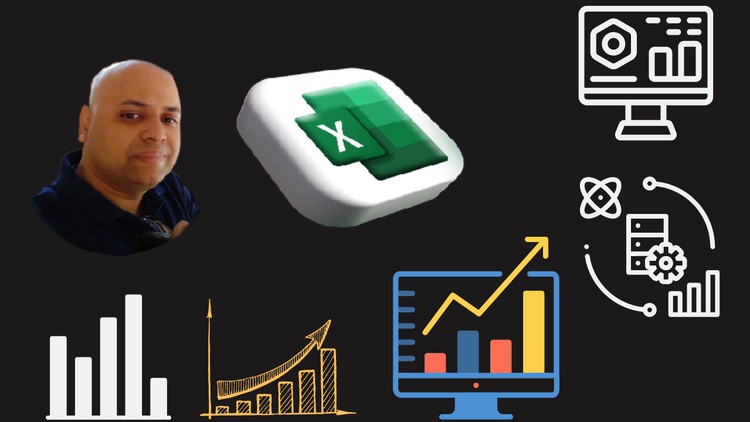
Learn how to efficiently search and retrieve data, perform calculations, and troubleshoot errors with VLOOKUP & HLOOKUP
What you will learn
Start by explaining what VLOOKUP/HLOOKUP is and why it’s important.
Understanding how VLOOKUP/HLOOKUP works and when to use it
Creating VLOOKUP/HLOOKUP formulas and using them to search for data
Working with multiple tables and using VLOOKUP/HLOOKUP to combine data
Troubleshooting common errors and problems with VLOOKUP/HLOOKUP
Applying advanced VLOOKUP/HLOOKUP techniques, such as using wildcard characters and nested functions
Provide examples of real-world scenarios where VLOOKUP/ can be useful. For example, a marketing analyst might use VLOOKUP to match customer data with sales data
Emphasize the practical benefits of taking the course. Students will learn a valuable skill that can improve their efficiency and effectiveness in their job.
Description
Welcome to our VLOOKUP/HLOOKUP course!
Are you looking to enhance your Excel skills and master the powerful VLOOKUP and HLOOKUP functions? Look no further! In this comprehensive course, we’ll teach you everything you need to know to become a VLOOKUP/HLOOKUP expert.
First, we’ll start with the basics, explaining what VLOOKUP and HLOOKUP are and why they’re important for data analysis. We’ll then guide you through creating VLOOKUP and HLOOKUP formulas step by step, using real-world examples and practice exercises. You’ll learn how to search for data in a table, retrieve values based on specific criteria, and perform calculations on your results.
Next, we’ll explore advanced VLOOKUP and HLOOKUP techniques, such as using wildcard characters, nested functions, and array formulas. We’ll also cover common errors and how to troubleshoot them, so you can be confident in using VLOOKUP and HLOOKUP in any scenario.
Throughout the course, you’ll have access to downloadable resources, including sample data sets and practice exercises, so you can apply what you’ve learned in a hands-on way. You’ll also have the opportunity to ask questions and get feedback from from me, I have years of experience working with VLOOKUP and HLOOKUP in real-world applications.
By the end of the course, you’ll have the skills and knowledge to confidently use VLOOKUP and HLOOKUP in your own work, whether you’re a business analyst, financial professional, data scientist, or simply an Excel enthusiast.
Don’t miss out on this opportunity to master one of Excel’s most powerful functions. Enroll in our VLOOKUP/HLOOKUP course today and take your data analysis skills to the next level!
What you will learn –
In a VLOOKUP and HLOOKUP course on Udemy, you can expect to learn a variety of skills and techniques related to these powerful Excel functions. Here are some of the topics you may cover:
- Understanding VLOOKUP and HLOOKUP: You’ll learn what VLOOKUP and HLOOKUP are, how they work, and when to use each function.
- Creating VLOOKUP and HLOOKUP formulas: You’ll learn how to write VLOOKUP and HLOOKUP formulas using the appropriate syntax and arguments.
- Retrieving data from tables: You’ll learn how to use VLOOKUP and HLOOKUP to search for data in tables, and retrieve values based on specific criteria, such as a customer name, product ID, or date range.
- Navigating large data sets: You’ll learn how to use VLOOKUP and HLOOKUP to navigate and analyze large data sets, such as sales reports, financial statements, and inventory lists.
- Performing calculations: You’ll learn how to use VLOOKUP and HLOOKUP in combination with other functions to perform calculations on your results, such as summing sales by region or calculating average inventory levels.
- Advanced techniques: You’ll learn advanced VLOOKUP and HLOOKUP techniques, such as using wildcard characters, nested functions, and array formulas, to perform complex data analysis tasks.
- Troubleshooting errors: You’ll learn how to troubleshoot common errors that may occur when using VLOOKUP and HLOOKUP, such as #N/A, #REF!, and #VALUE!, so you can fix problems and get your formulas working correctly.
By the end of the course, you’ll have a solid understanding of how VLOOKUP and HLOOKUP work, and how to use them to efficiently analyze and manipulate data in Excel. You’ll also have hands-on practice using these functions with real-world examples, and the ability to troubleshoot errors that may arise. With these skills, you’ll be able to use VLOOKUP and HLOOKUP to work more effectively and make data-driven decisions in your work or personal projects.
Content